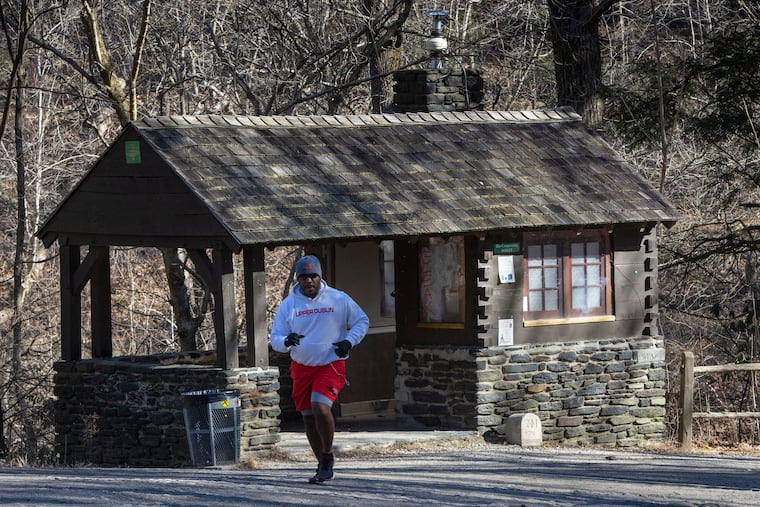Wissahickon Valley Park could need $2 million to add enough toilets to handle its crowds
A single new toilet can cost up to $140,000. Further, all facilities combined could cost an estimated $185,000 a year to maintian.

Philadelphia’s Wissahickon Valley Park gets 2 million visitors a year but has only 15 permanent toilets. By comparison, Valley Forge National Historical Park, at twice the size, gets the same number of visitors but has 55 permanent toilets.
So, more than 1 in 10 Wissahickon Valley Park users admitting to simply taking to the woods.
In an effort to accommodate the rise in visitors over the years, the city’s Parks and Recreation Department and its partner, the nonprofit Friends of the Wissahickon (FOW), are creating a master plan to upgrade the restroom facilities.
» READ MORE: Wissahickon Valley Park has ‘urgent’ need for more bathrooms
They’re finding it won’t come cheap: New estimates by consultant NV5 show it could cost up to $2 million to install a wish list of restroom facilities depending on the type of facility and toilet. The cost could be substantially different if the list is pared down or cheaper alternatives are chosen.
However, a single new toilet can cost up to $140,000. Further, the facilities combined would also cost an estimated $185,000 a year to maintain.
Why would toilets be so expensive?
Ruffian Tittmann, executive director at Friends of the Wissahickon (FOW), says the estimates may seem high, but there are reasons.
“You could possibly build a new home for the cost of a toilet,” Tittmann said jokingly.
“But these are challenging locations,” she said. “Just getting materials to a site is expensive. And we’re not talking about little stick buildings but concrete. There is engineering needed, sewer connections that have to be made, or drilling wells. So you essentially are doing either a complete home renovation or building a new house, although it seems like all you’re doing is building a new bathroom.”
Facilities have to comply with the Americans with Disability Act accessibility guidelines and need access to paved roads. They have to be placed away from ecologically sensitive areas. And they can’t be located in floodplains. Security is also a consideration.
The park sprawls across 1,800 often rugged and rocky acres and is crisscrossed by 50 miles of trails and, of course, the creek. Some of its facilities date to 1936 when the Depression-era Works Progress Administration sought to employ people through public projects.
Yet a survey found about a quarter of park users need a restroom each time they visit, with almost a third saying they “frequently” need one. About 12% say they use “nature’s restroom” while visiting, leading to public health concerns, although there is no indication of pollution to the Wissahickon Creek.
Park goers have also requested dog hitches near the bathrooms, as well as water fountains or bottle filling stations.
In all, the facilities include seven women’s toilets, five men’s, three unisex, and five urinals. But most of those are not open year-round.
Where are the restrooms?
Here is the current mix of toilet facilities at Wissahickon Valley Park:
Kitchens Lane and Forbidden Drive: One composting toilet; one seasonal portable toilet year-round.
Wissahickon Environmental Center: Two composting toilets year-round.
Valley Green Inn: Two women’s toilets and one men’s flush toilet plus urinal year-round.
Blue Bell pavilion: Two women’s and one men’s flush toilet plus urinal, but seasonal.
Pachella pavilion: One women’s and one men’s flush toilet plus urinal but seasonal.
Bells Mill Road: Two seasonal portable units.
Northwestern Avenue parking area: Two seasonal portable units.
Allens Lane: One seasonal portable toilet.
David P. Montgomery Field: One seasonal portable toilet.
So what’s the plan?
Friends of the Wissahickon is considering the addition of eight unisex toilets in existing buildings and 16 potential toilets plus urinals. The group is considering well drilling to provide water at sites without public water. But composting toilets are not being proposed because “the high frequency of use would render the function of a composting unit unfeasible.”
Location is also a consideration. Increasingly, the southern part of the park, which has the least bathroom access, is seeing heavier use. So the master plan could call for a facility at what’s known as Ten Box (Blue Stone Bridge) in the lower third of the park. An existing stone and wood building there built in 1939 would have to be renovated. It currently has sewer and electric but no public water so a well would have to be drilled.
Park goers also expect more than in decades past. Surveys show they want handwashing sinks and water bottle stations. Diaper changing stations are also a considerations.
Overall, officials can’t just start using more portable toilets. The monthly cost for portable units at just one location, Valley Green, runs $2,856 just in August during peak crowds.
Meanwhile, a “vault toilet” or freestanding single structure with one restroom that officials are considering can hold the equivalent waste of 16 portables.
The master plan could also call for “adaptive reuse” of older buildings, such as Ten Box, or, as another example, the existing warming shed at Valley Green. It could hold two new restrooms accessible from heavily trafficked Forbidden Drive. But utilities would have to be run and the building would have to be flood-proofed.
The master plan is still being formulated. The FOW has setup an interactive map for the public to comment on where they’d like to see facilities.
“Right now the master plan process is really helping us prioritize,” Tittmann said, noting that no source of funding for toilets has yet been identified.
blue stone